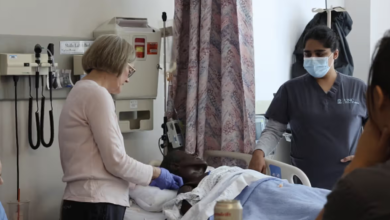Why Nursing Organizations Endorse Political Candidates

Disclaimer: Nurse.org has not ever endorsed specific political parties or persons.
Many prominent and leading nursing organizations in the country play a role in legislating, as well as promoting and supporting, key pieces of legislation that can affect healthcare. However, not all nursing organizations outright support specific political candidates.
Some nursing organizations that do endorse specific political candidates, such as the National Nurses United (NNU), which recently announced their endorsement of a Presidential candidate, may choose a specific candidate every year, or only choose to endorse candidates that they feel will strongly support a cause they wish to further. In other words, even if a nursing organization has historically supported political candidates throughout the years, that could change in the future.
The reverse is also true. For instance, the Washington State Nurses Association (WSNA) just chose to endorse a presidential candidate for the first time in the organization’s 121-year history. So why do nursing organizations endorse certain candidates?
Here, we break down why certain nursing organizations may become involved in supporting specific political candidates, how nursing organizations are involved in legislation, and the impact that nursing organization’s endorsements can have on elections and ultimately, policies.
Nursing and Politics
Some formal nursing organizations, such as the American Nurses Association (ANA), believe that advocacy at the legislative level is a pillar of nursing. For instance, the ANA’s statement on Federal Advocacy states that “legislative and political advocacy is no less important to advancing the profession and patient care.”
The ANA’s official stance on healthcare policy adds that as the leading organization representing the interests of the nation’s 5 million registered nurses, ANA’s role is “to articulate that voice at the highest levels in order to influence health policy.”
A 2021 journal article, Policy, Politics, and Nursing Practice, even argued that “policy advocacy is a fundamental component of nursing’s social mandate,” and that nursing organizations should lead the way in political advocacy over efforts by individual nurses. The journal noted that nursing advocacy is a powerful force that has been largely underutilized historically in the nursing profession, adding that “advocacy groups are considered one of the most powerful forces in shaping policy agendas, processes, and outcomes.”
The journal also pointed out that because nursing political advocacy is a relatively new and growing movement, more research and work are needed to ensure that the political decisions these organizations are making are in line with the majority of public nurses’ beliefs and wishes, a topic that is challenging to study, as nursing is a diverse field.
Regardless, since that journal article was published in 2021, there has been increasing political advocacy by many nursing organizations, at both the federal and state levels. For instance, the ANA has a federal and state advocacy arm, as well as a grassroots arm to support nurses at all legislative levels. They also have an official Political Action Committee, the ANA-PAC, which releases a formal list of political endorsees every election season. The ANA’s Capitol Beat blog details ongoing political updates, legislation, and advocacy efforts from every level to keep nurses informed.
In short, nursing organizations are expanding their political reach in an effort to make a difference in causes they believe matter to the future of nursing.
The Washington State Nurses Association, provided remarks regarding their recent endorsement of a candidate, “As the first state to deal with COVID, and an association with nurses from almost every clinical area, we felt compelled to endorse in this race so that a professional nursing association voice was included in the dialogue,” Justin Gill, DNP, APRN, RN, an urgent care nurse practitioner and President of the Washington State Nurses Association (WSNA), which represents over 20,000 nurses in WA (both union and individual professional nurses) says.
While the ANA is declining a formal presidential endorsement this year, as it did last election cycle, Gill says the WSNA made the decision to endorse based on their “values and priorities.”
“As nurses, we are not afraid to speak up and advocate for our patients and our communities in every venue, from the bedside to Olympia to Capitol Hill and the White House,” the WSNA said in a press release. “As we do in our direct care of patients, we as a profession have a responsibility to take a stand when we face circumstances that have a direct impact on nurses and patients. In the face of serious consequences for nursing and our healthcare system, remaining silent in this election would be antithetical to our identity as nurses and patient advocates.
“Nurses are repeatedly ranked the most trusted and ethical profession in the United States for a reason: we stand as fierce advocates for what is right for the health of our communities regardless of headwinds we may face. It is our view that we are compelled to take a public stand in this consequential election year.”
Gill adds that the WSNA is devoted to furthering various issues related to access to care, labor rights, safe staffing, and bolstering the nursing workforce. The organization also hopes to help elect a “pro-labor” President.
Gill points to the power that electing a specific candidate can have, highlighting why nursing organizations may choose to endorse a specific candidate in the first place.
“The vast majority of our members are represented through collective bargaining. At the federal level, the National Labor Relations Board members are appointed by the president,” Gill explains. “The labor board holds tremendous power over workers’ rights in organizing, collective bargaining, and resolving workplace disputes. The previous administration appointed members who rolled back union rights. The current administration has appointed pro-labor members who have expanded those rights, which helps WSNA serve our members better in their local units, and will ensure that employers are held accountable. We need to see that trend continue.”
“The President also appoints the top officials of the U.S. Department of Labor and has the power to sign or veto pro-labor legislation passed by Congress,” Gill adds. “We need a pro-labor President in the White House.”
Gill tells Nurse.org that WSNA also hopes Harris will continue to demonstrate the support she has shown in the past for safe staffing. “Vice President Harris was a key supporter of the minimum long-term care staffing rule from CMS,” Gill notes. “It is our hope that she works to expand staffing standards for other healthcare environments, workplace violence legislation, along with programs to help future nurses with improved nursing program capacity, and student debt.”
Like all political advocacy groups, there are a few different ways that nursing advocacy groups work to influence legislation and policy change, such as through:
- Monetary donations
- Lobbying of political members for causes
- Awareness and advocacy events
Each nursing advocacy group sets its own rules for how and what political giving will be done. For instance, the ANA-PAC says it has “strict criteria governing its giving strategy with a political budget approved each cycle by the ANA-PAC Board of Trustees.” The PAC further details that it “invests in members of Congress and committees that support ANA’s legislative priorities and the nursing profession.”
According to the ANA-PAC’s 2021 report, as just one example of how a nursing organization evaluates political candidates, ANA staff evaluate potential candidates by the following criteria:
- Reviewing the candidate’s position and/or voting record on issues impacting registered nurses, evaluating if the candidate is in a leadership position within their party
- The candidate serves on a committee that has jurisdiction over health policy
- A candidate’s viability in a given election
- Recommendations from PAC member(s) of candidates who are supportive of ANA’s legislative priorities
- Contributions to the leadership PAC of a member of Congress when in a leadership or relevant committee position
According to their website, ANA-PAC used to formally “endorse” political candidates in a larger number of races. They now “financially support” candidates, and formal endorsements are limited to a “handful of candidates” who are often incumbents.
The official stance of nursing organizations’ political advocacy is overall support of policies and legislation that are helpful to the nursing field, not specific party affiliation, but the organizations do release how their funding is dispersed.
For instance, in 2021, the ANA-PAC spent $111,000 (56%) towards federal Democratic candidates, PACs, and party committees vs. $88,850 (44%) towards Republicans, and similarly, in looking at federal candidates only, the organization put forth $88,500 (55%) towards Democratic candidates vs. $73,500 (45%) towards Republicans.
The ANA’s current policy does not recommend any formal endorsement process . This was changed in 2019. The authority to make an endorsement now currently rests with the ANA Board of Directors which will not be endorsing any candidate this year after discussion of this at the 2024 ANA Membership Assembly.
For the 2024 election, the ANA has declined to endorse a specific presidential candidate so far, but the organization does have a graphic detailing how the two presidential candidates align on ANA’s key political issues
Aside from influencing formal legislation by endorsing specific candidates, nursing organization advocacy can also raise awareness and bolster support among individual nurses, which is a crucial part of enacting change. For instance, the ANA held a Hill Day in June 2024, inviting nurses and nursing students to be part of a breakfast and briefing on Capitol Hill that touched on the organization’s four key goals:
- Restricting Mandatory Overtime for Nurses
- Nurse Faculty Shortage Reduction Act (H.R. 7002, S. 2815)
- Improving Care and Access to Nurses (ICAN) Act (S. 2418, H.R. 2713)
- Protect Timely Access to Quality Nursing Care in LTC Facilities—despite being implemented in Congress already, there is an effort to overturn this current legislation
Gill also points out that nursing organizations supporting specific political candidates can help protect legislation that has already passed and prevent it from being blocked or repealed—even successfully passed legislation may not last if a candidate who has opposing beliefs is elected, an important distinction that some outside of the political sphere may not understand.
“It is important that we work to protect programs and legislation that have positively impacted the nursing profession and the patients we care for,” Gill explains. “Some of these include the Affordable Care Act, measures to cap insulin prices as part of the Inflation Reduction Act, allowing Medicare to negotiate drug prices, and access to reproductive care. Issues related to advanced practice nurses have had bipartisan appeal in the past, and could be an area of interest.”
The official stance of nursing organizations that endorse specific candidates is that they do so when their leadership members believe that a specific candidate will further a key cause or policy identified by the organization. Nursing organizations do not endorse partisan candidates and do have ethical guidelines and policies in place to make a political candidate endorsement.
Because of the guidelines necessary to choose a candidate, not all nursing organizations that do endorse political candidates have released endorsements for the 2024 election season yet. For instance, the ANA-PAC has yet to release any specific endorsements and does not plan on endorsing a presidential candidate.
Specific seasonal candidates aside, however, political advocacy by nursing organizations can help shine a light on current and pending legislative efforts that could affect the current working landscape for nurses, as well as the future. Especially for nurses who are members of these nursing organizations, understanding how the nursing organizations you belong to contribute to political candidates, choosing what candidates to endorse, and supporting those candidates’ political moves can be important.
Nurses can use the political endorsements made by nursing organizations as a starting guide to learn more about political candidates, and their past and current political efforts, and consider how these endorsements align with their own views and values in upcoming elections. And lastly, of course, all nurses should vote for the candidates and issues that matter to them, both at national and local levels, and get involved however they can to share the issues that working nurses are seeing on the ground level.
“While most nursing priorities appeal to people with diverse political ideologies, nurses should be committed to advocating and working with any elected lawmaker. Issues that affect nurses and patients transcend political party,” notes Gill.
“No matter who is elected to serve it is important that we continue to advocate for policies that benefit nurses and patients while continuing to tell our stories. The broad swath of individuals in this country can agree that significant change is needed in how we deliver care and the systems that support that care. Nurses care for patients that have various political beliefs, and we can certainly advocate for our concerns with lawmakers of any political ideology.”







